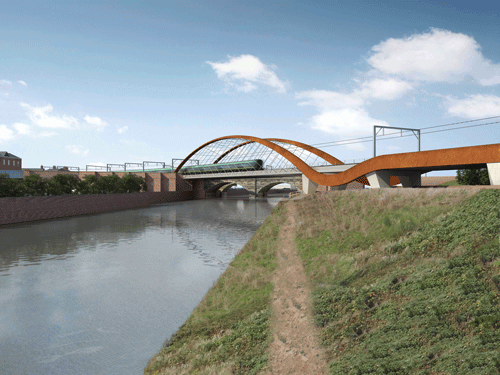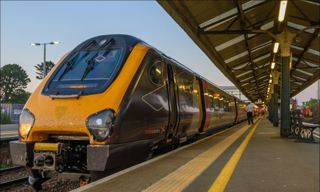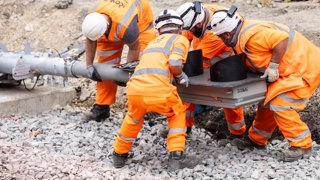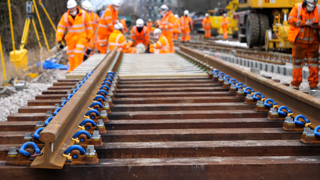On September 15 1830, the Liverpool and Manchester Railway ran its first passenger-hauling service, under fluttering pennants and surrounded by cheering crowds.
MP William Huskisson famously died after being run over by Stephenson’s Rocket on that first day of operation, making the opening a national scandal. People cowered at the idea of travelling at breakneck speeds of 25mph, but the railway age had begun, spectacularly so, and the faces of the two cities served by the line were changed forever.
At the Manchester end of the line, the station at Liverpool Road is the world’s first passenger railway terminus. It was designed to be used more as a warehouse than a station, but the building of Water Street Bridge (arguably the first modern girder bridge in the world) meant passenger facilities had to be taken into consideration.
The station is now the home of the Museum of Science and Industry (MoSI), part of the Science Museum Group.
Today the museum is capable of running short steam-hauled rides for visitors along a few hundred yards of the original Liverpool and Manchester Railway trackbed. The line stops where the tracks join the national network, but can be used to allow heritage specials or other stock to arrive at MoSI off Network Rail metals.
But all this will come to a halt if the Ordsall Chord is built. The Chord is proposed to link the line through Piccadilly with Manchester Victoria, and (for example) from 2017 trains from Yorkshire and the North East will traverse the Chord to reach Manchester Airport. There will be easier and smoother movement of trains in central Manchester and hugely improving connectivity across much of the North.
Approval of the Transport and Works Act Order was granted by Secretary of State for Transport Patrick McLoughlin in March (RAIL 772).
Work was due to start on building the Chord across the River Irwell (adjacent to Liverpool Road) in September, but this was then delayed by a legal challenge (RAIL 776). The project was already severely delayed, with its cost currently expected to be in the region of £132.7 million, according to official Network Rail documents.
However, the now-approved Chord (see pages 6-7) will cause significant damage to some of the buildings and bridges around MoSI, and will cause the line to be truncated, although MoSI will still be able to operate demonstrations.
Understandably, this is causing concern for a number of local user and heritage groups. Some believe that the balance between heritage and progress is swinging the wrong way, so can a happy medium be found?
For a short time, Mark Whitby was a consultant engineer for Network Rail on the project. He says that he resigned because Network Rail failed to consult the public properly, failed to look into alternatives to the current plan, and failed to address the issues the current plan raises.
In May, Whitby launched a legal challenge to the Ordsall Chord, delaying the project hugely in order to fight his corner.
“There is a viable alternative that will cause the delay of the development of the Middlewood Locks, but ultimately it will be for the good,” he says.
Whitby, the former president of the Institution of Civil Engineers, funded his challenge personally. He not only tried to delay the Chord’s construction, his intention was to stop it entirely - not because he is against the project to improve capacity, but because he is in favour of preserving the station at Liverpool Road. He believes that the scheme would damage unnecessarily the world’s oldest station. His alternative plan, Option 15, was suggested as a better course of action to take.
Option 15 involves the line being built higher and on a slightly tighter radius than the current Ordsall Chord scheme. Built on a more westerly alignment, it would still allow six-car trains to enter Manchester Victoria, and would (according to the plans) allow full-height bridges to be built across Liverpool Road.
This would negate the need to damage the Grade 1 listed structure of the station and railway bridges, which is what the current Ordsall Chord plan would involve.
However, the route would cross the Middlewood Locks, for which Salford Council has advanced plans for a major redevelopment. And this option would cost a further £20m, would take another five years to approve, and could cause the loss of the council’s development plans.
With this in mind, Network Rail’s position has been clear. It says: “Network Rail remains committed to delivering the benefits of the Northern Hub, which will provide space for hundreds more trains each day and room for millions more passengers. The Ordsall Chord will play a key part in enabling faster, more frequent trains and more direct services to Manchester Airport.”
NR’s stance is that the Ordsall Chord design chosen is the best for Manchester, as it is cheaper, quicker to build and quicker to bring into service than Option 15. The Department for Transport also contested Whitby’s legal challenge against the decision to allow the building of the Chord.
The planning report acknowledged that significant damage will be caused - if not to the buildings themselves, then to their contexts and surroundings, which can potentially have just as much impact on an area’s history as a full demolition of a building.
The conditions included Network Rail assisting MoSI in opening up land that the Chord would not affect, thus allowing the museum to increase its use of the land around the railway, despite the scheme causing significant damage to the museum’s ability to run trains.
MoSI claims that its withdrawal is not related to the £3 million being offered by Network Rail, and that its heritage rail services will continue. It says the Chord will not detract either from the rail services or the heritage attractions linked to them.
In this day and age, a museum cannot be entirely blamed for deciding to accept such a potentially life-saving cash injection (bearing in mind that MoSI is a part of the National Museums of Science and Industry, and therefore a government entity that includes the National Railway Museum).
So is the Government and all those involved with the Northern Hub process all putting progress before the railway’s heritage? In some instances yes, undoubtedly. Signal boxes, many unique, are demolished every month. Many of the rail network’s lesser buildings are swept aside without any regard for the thousands of man hours that were worked within them.
In its application, NR even admits the damage that is going to be caused by the Chord: “Although a number of the impacts when considered in isolation can be considered to cause less than substantial harm, the extent of the proposals and number of impacts could be said to result in an overall accumulative impact which is of substantial harm.”
And yet, in other parts of the country, more bridges, buildings and railway heritage assets are being preserved than ever before.
Brunel’s viaduct at Maidenhead is being given special consideration in a way that any right-thinking planning expert would approve. Lightweight, low-profile overhead line equipment is being used after consultation with local residents and authorities (RAIL 776).
The viaduct at Hewenden (see feature, pages 70-75) is an example of a piece of railway heritage once thought useless that is now being put to good use.
Then there’s the St Pancras renovation… the retention of the former signal cabin at York… Scarborough’s ‘long bench’… the list of features being retained (some despite their redundancy) goes on.
Can we learn lessons from railway heritage overseas, where railway heritage is often integrated successfully into large and modern schemes?
One example is Paris Gare du Nord station. The 1889 train shed and spectacular frontage has been preserved, while inside the reorganisation of platforms and installation of relatively unobtrusive overhead line equipment has allowed the atmosphere of the departure area to be retained.
And yet the 1889 improvement work involved the wholesale rebuilding of the original 1840s station, which has been absorbed and its style significantly altered.
Another example of a heritage asset’s recognition bringing long-term benefits and praise is the retention of the Grand Central terminus in New York.
In 1968, plans were drawn up to build a large tower block on the site, destroying the dilapidated facade of the little-used station. The railways in the US had declined rapidly, and it was thought the building’s heritage value was outweighed by the progress and new vitality to the economy that more office and trading space would bring. However, the station was designated a landmark of the city of New York, and was saved.
Former First Lady of the United States Jacqueline Kennedy Onassis succinctly stated the case for the preservation of historic landmarks in the city: “Is it not cruel to let our city die by degrees, stripped of all her proud monuments, until there will be nothing left of all her history and beauty to inspire our children? If they are not inspired by the past of our city, where will they find the strength to fight for her future?”
Having said this, the original head house of Grand Central, a huge piece of early American railroad history, was demolished in the early 20th century to make way for the much-lauded terminus we see there today.
Back in the UK, is Liverpool Road similarly such a landmark? Arguably so. Would its fully intact preservation be considered a wise move in the future? That remains to be seen.
There is an obvious link to be drawn here between the Ordsall Chord and the Euston Arch (RAIL 601). The perceived unnecessary removal of the latter, and the ensuing sense of loss and tragedy felt by many after its demolition in 1961, could be seen as a precedent.
English Heritage even mentions this in its objection to the Ordsall scheme, although Planning Inspector Brendan Lyons dismisses it, believing it to be an entirely different situation.
Protests against the demolition of Euston Arch came from preservationists including Sir John Betjeman, while Prime Minister Harold McMillan was even approached and begged to save it. The prohibitive £190,000 cost of its being moved was roundly defeated by the £12,000 demolition cost, however, and the Arch was lost.
Its remains were dumped into canals, and its gates are now in the National Railway Museum in York. The lodges that survive it are now all that is left of the original station at Euston, which was demolished in 1962 just after the arch. Will the Ordsall Chord echo Euston’s description as being “one of the greatest acts of post-war architectural vandalism in Britain”?
English Heritage continued to oppose the Ordsall Chord plans vociferously, even after they were approved by the DfT Planning Officer. Its objection to the Ordsall Chord Order (submitted in October 2013) notes significantly that the Network Rail proposal is at odds with the National Planning Policy Framework (NPPF), a guideline by which planning proposals are assessed.
The NR proposal states the work would be done in a way that would allow the heritage assets to be assessed and recorded prior to work beginning. But English Heritage points out that the NPPF states: “The ability to record evidence of our past should not be a factor in deciding whether such loss should be permitted.”
English Heritage has remained comparatively quiet on the subject in recent months. But at the first inquiry into the project, Scott Lynes, its legal representative, made a highly emotive closing statement: “There is a troubling irony in such a severe magnitude of harm to our railway heritage being caused by a railway line, as promoted by a guardian of our railways infrastructure.
“While Network Rail has to a large extent acknowledged that harm, English Heritage remains deeply concerned to ensure that the damaging effects of this scheme are fully understood by the Secretaries of State.”
He went on to address McLoughlin, asking him to “demonstrate the same sense of and respect of our heritage as was shown when… decrying the decision to demolish the Euston Arch. The great fear of English Heritage is that if the proposed Ordsall Chord is allowed as a result of this order, it will be too late to address the deep regret that its exceptionally adverse effects are likely to cause.”
However, many consider these exceptionally adverse effects to be not sufficiently adverse as to warrant a delay in the project. Manchester City Council is becoming increasingly impatient at the delay to its new railway link, part of the “Northern Powerhouse” plan that is of great appeal to many public authorities in the north of England.
“I find the comparison with the demolition of the Euston Arch made by English Heritage and others not to be particularly helpful to the decision,” says Lyons.
“That involved the demolition of an iconic structure, totally erasing its significance and radically changing the context. In this case, the primary assets would remain intact, and could continue to be appreciated at an individual level, even though the relationship between them would be heavily disrupted.”
Whitby is not alone in his objections to the Chord. Sir Neil Cossons, former chairman of the Science Museum and head of English Heritage until 2007, is also against the project as it stands. He firmly believes that Manchester’s heritage has influenced the world’s industries and social development to such an extent that its heritage must be preserved as far as possible.
“The Ordsall Chord is crucial, but thoughtful planners and good designers can reconcile these voices of the past with the needs of tomorrow,” he told the Manchester Evening News.
“Liverpool Road Station and its environs deserve better. That is what today’s debate is all about. There is still time to get it right, and Manchester should be leading the charge to be the North’s intelligent powerhouse.
A surprising celebrity backer of the scheme is Pete Waterman. The locomotive owner and repair facility founder is very much in favour of the Chord progressing. As he views it, heritage must not stand in the way of improving the lives of working people.
Will the Chord bring benefits to the north of England? Of that there is surely no doubt. Trains will operate more smoothly, capacity will be improved, and flow will loosen up in Manchester, which is already a highly congested railway city.
It will allow a far wider range of inter-regional services across the city, something dreamed of since Victorian times.
But will the potential disruption caused to Liverpool Road damage the lives of people in the north of England? Again, it would appear so. The loss of a unique heritage asset is always a negative, and there is a view that one that could potentially be saved through an alternative means of building the Ordsall Chord would be doubly tragic.
If, as Whitby suggests, Option 15 was not fully considered due to financial constraints, should more time and funds be spent on finding a way for the world’s first passenger station to continue to serve the city that built it unscathed? This is one of the points raised by English Heritage in its 2013 objection - it believes the station and bridge are still able to be appreciated as working railway structures.
The acknowledgement by the Planning Inspector that severe disruption would be caused to internationally significant heritage assets is a good indication in many cases that a proposal is to be rejected.
In this instance, however, the decision to approve was granted despite an alternative being given by Whitby, and despite serious objections from MoSI and English Heritage. And a winner has now been announced, and the Ordsall Chord is a fully-funded Control Period 5 scheme.
Often, developers and preservationists can work in harmony, but something in Manchester seems to have gone awry. Will Ordsall Chord now end up bulldozing part of the national heritage?
- This feature was published in RAIL 786 on October 28 2015
















FrankH - 28/01/2016 16:01
The first sentence, last paragraph on page one says it all. Cheaper and quicker to build.